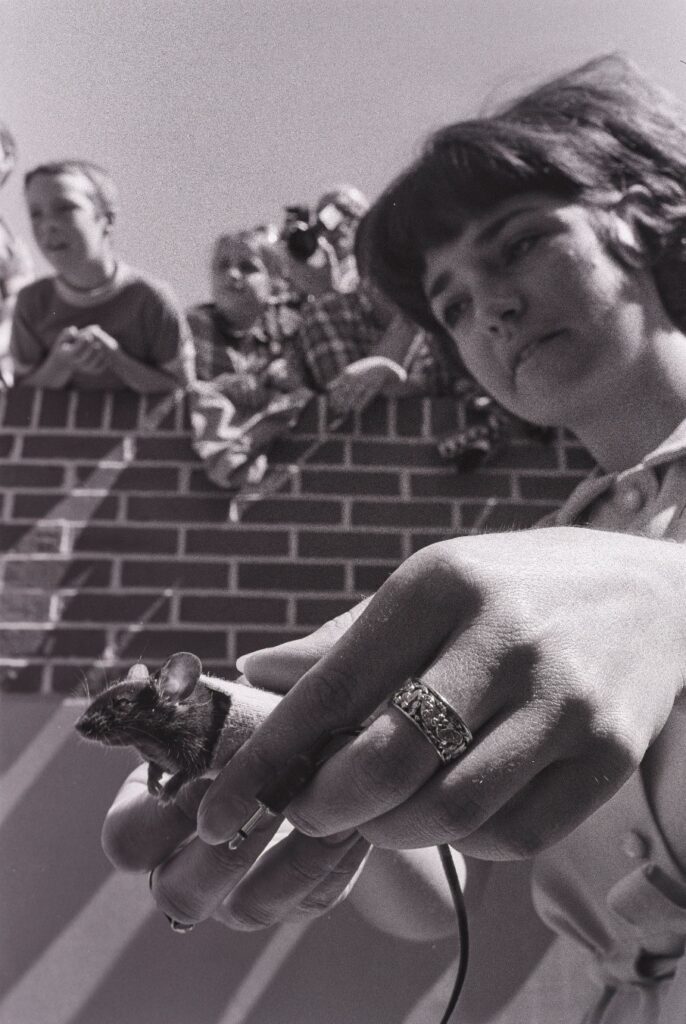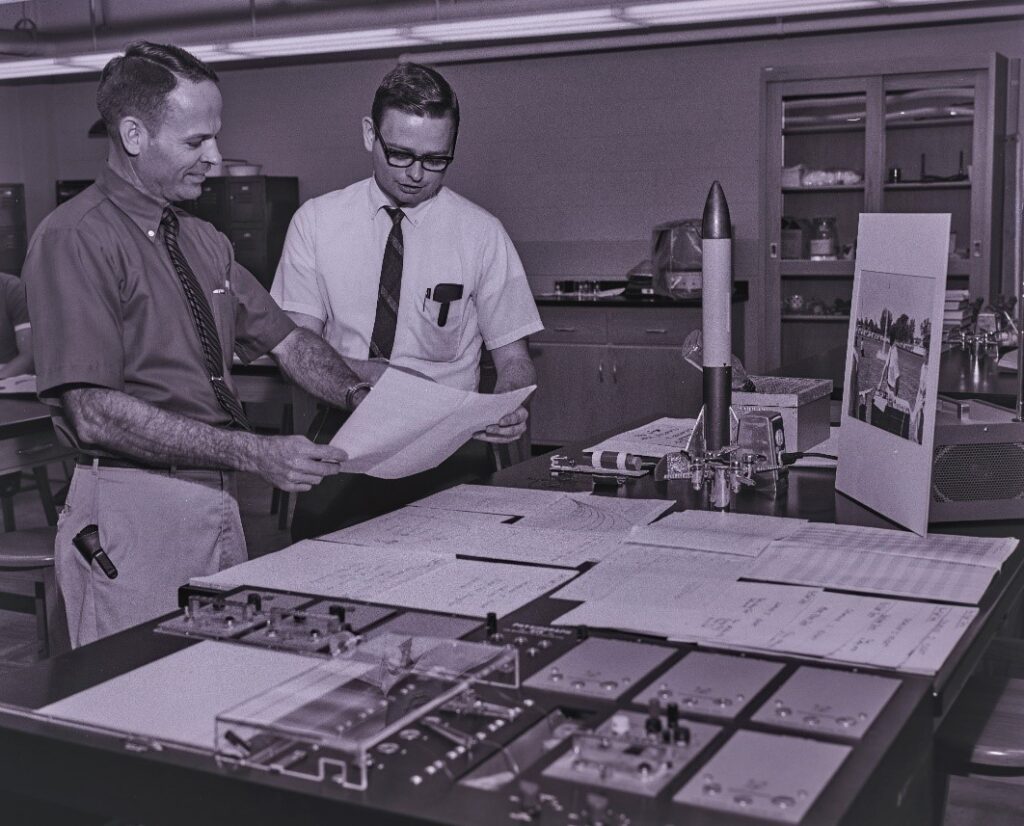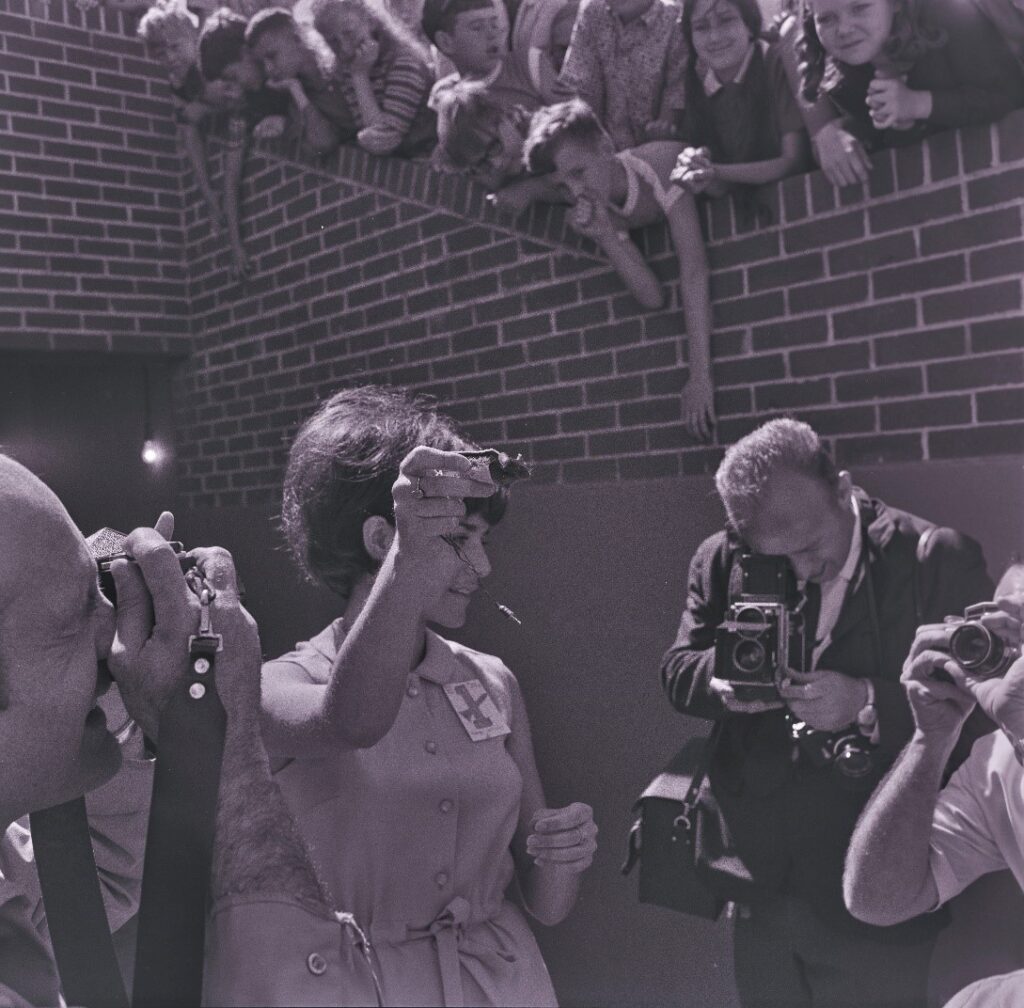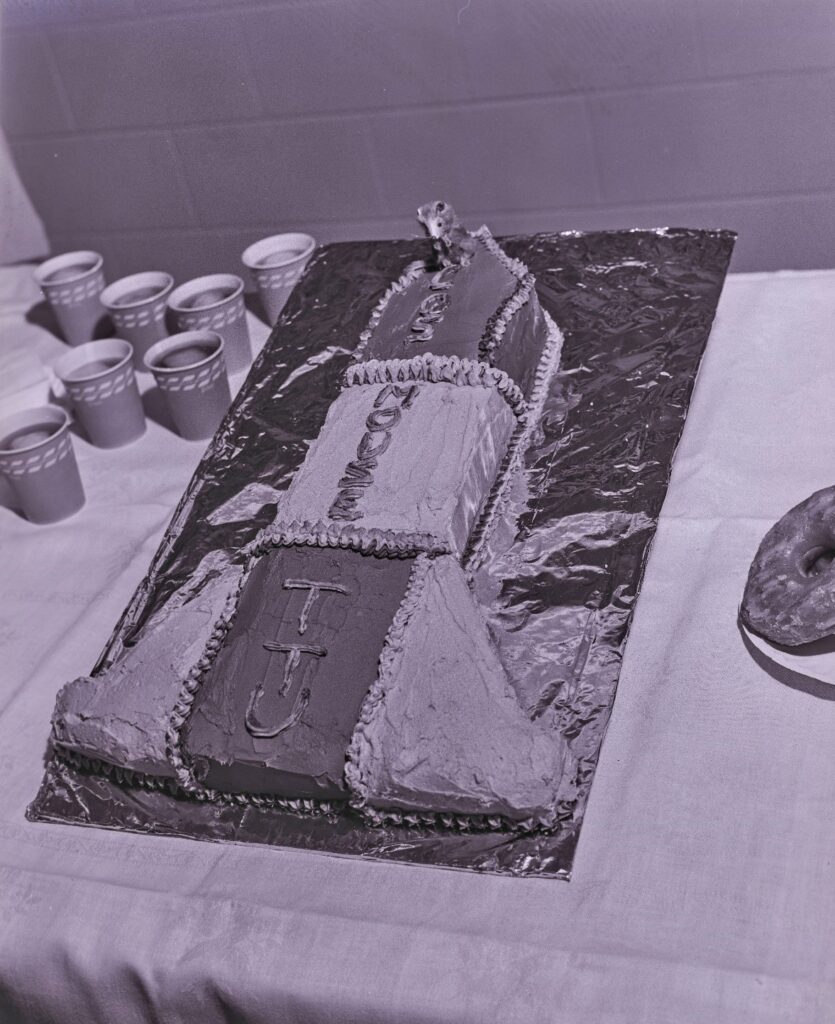Cosmouse (1970-1971) was a black-furred mouse who traveled 1,000 feet in the atmosphere at approximately 21.3 G-force in a student-designed mini-rocket on May 18, 1970, in a project led by Dr. Elmo Dooley, a professor of biology.[1] The experiment was to test the mouse’s physiological changes using bio-instruments on the mouse as it traveled in the air, illustrating to students some of the many complications of space flight and telemetering biochemical information.
Cosmouse was only five weeks old when he took his death-defying journey, placing his life in the hands of a Tech professor and his students. He received his name from Elmo Dooley’s students. In preparation for the flight, he received a spacesuit in double-knit polyester designed by Betty Dooley, Elmo’s wife. The launchpad was 8 inches wide and was embellished in purple and gold, Tech’s school colors. Cosmouse and Astromouse, Cosmouse’s potential backup for the journey, received steak and scrambled eggs two days before the journey, a high protein meal “just like our astronauts” receive, said Dooley.

Although he was no bigger than the palm of your hand, Cosmouse successfully and safely made the flight due to the students’ rocket design and the life-supporting equipment provided by Dooley. Students monitored his heart and respiration on equipment provided by Dooley. The students and professor provisioned the mouse to withstand 21.3 G-force, the same amount used in early NASA centrifuges for astronaut training. Without these measures to protect Cosmouse, he would have suffered a major spinal cord injury. The instruments for protecting and monitoring Cosmouse were installed and a mini-couch was provided for his comfort.
This type of project was not new to Dooley. Prior to doing the Cosmouse experiment, Dooley had expertise and experience with microorganisms in closed crafts and in designing systems to be used in United States space flights for NASA and the Air Force. In 1959, he also participated in the launch of America’s first monkeys in space including a rhesus monkey, Able, and a squirrel monkey, Baker.


The launch of Cosmouse did not go unnoticed by many humane societies who expressed their displeasure in the treatment of Cosmouse and unsuccessfully sought to prevent the launch. The initial launch planned for May 15, 1970, was delayed due to weather and Cosmouse instead took off on May 18, 1970, at 10:05 a.m. from Overall Field. Three hundred spectators arrived for the launch, including Tech students, Tech Training School students, and various reporters for newspapers and television. After a successful launch and two minutes in the air, the rocket burned out the solid fuel engine, and the rocket separated into two parts which returned to Earth by parachute. The part of the rocket containing Cosmouse landed within five feet of the student’s projected landing site. Physiologically, Cosmouse experienced readings that were more than double his normal respiratory and heart functions.
The flight and Cosmouse were featured as front-page headlines in local newspapers. John Bullock, an author for The Oracle, wrote of the mouse’s amazing journey: “Every mouse in the country will put Tech at the top of their list for areo-space studies.” Although Bullock’s prediction did not seem to come to fruition, the project was awarded the Outstanding Engineering Project of the Year by the American Society for Engineering Education and later became a display for Engineering Day in 1971.

Despite the taxing journey, Cosmouse purportedly outlived his litter mates. He reportedly died of old age in January 1971.[2] His death spurred a second round of media reporting, including the first page of some local newspapers. Although it is unconfirmed, Dooley said Cosmouse would be mounted, preserved, and made a specimen in Tennessee Tech’s Biology Department. The experiment itself was imitated by Thurman Francis Junior High School in Smyrna, Tennessee with another adventure mouse, Midget.
Students who participated in the experiment were from Dooley’s instrumentation class and included David M. Jones, Robert S. Becker, Janice E. Lynn, Sabina Mackie, Bobby Gelen Malone, Glen E. Mysza, Frank K. Umberger III, Delbert Lee Wynn, and Richard Frounfelker. The Dooley family including Elmo’s wife Betty, and sons Leroy and Joseph also participated in the Cosmouse experiment
[1] Records generated from 1970 and 1971 suggested Cosmouse went over 1,000 miles into space, but reports from 1983 suggested the mouse traveled 3,000 feet. The potential error was not corrected by Dooley and was likely reported incorrectly in all subsequent publications after 1971. The launch took place on May 18, 1970, but in the 1971 The Eagle yearbook misprinted the launch date as May 22, 1970, likely due to the date printed on the Photo Services photographs.
[2] The average laboratory mouse lives 26-30 months.
For more images of the Cosmouse story, visit our digital collections at this website: https://tntech.access.preservica.com/?s=Cosmouse&hh_cmis_filter=xip.content_type_r_Display%2Fimage
Bibliography
“’Cosmouse’ back A-Ok After Trip,” The Tennessean, May 19, 1970, 1-2.
“Cosmouse Could Die in Flight,” The Tennessean, May 9, 1970, 32.
“Cosmouse Due to Fly; Monday,” The Daily News-Journal, May 17, 1970, 9.
“’Cosmouse’, Intrepid Air Voyager, Ends Career,” The Daily News-Journal, January 6, 1971, 1.
“Cosmouse May not Go, He Hopes,” The Tennessean, May 14, 1970, 4.
“Cosmouse Remembered,” The Oracle, Tennessee Technological University, February 26, 1971.
The Eagle yearbook, Tennessee Technological University, 1971.
“Engineering Design Class Plans Module,” The Oracle, Tennessee Technological University, December 4, 1970, 1.
“Local Students Visit Tech,” The Jackson Sun, March 3, 1971, 24.
“NASA Consultant: Dooley Continues Space Work,” The Oracle, Tennessee Technological University, Vol. 56, No. 15, February 17, 1978.
“One Small Step for a Mouse…” The Oracle, Tennessee Technological University, Vol. 47, No. 27, May 22, 1970.
“Tennessee News Briefs,” Johnson City Press, May 19, 1970, 9.
“Thurman Francis Jr. High Enters the Space Age: Students Get Firsthand Rocketry Demonstration,” The Rutherford Courier, November 4, 1971, 1.
